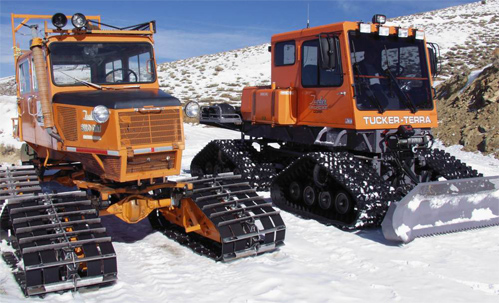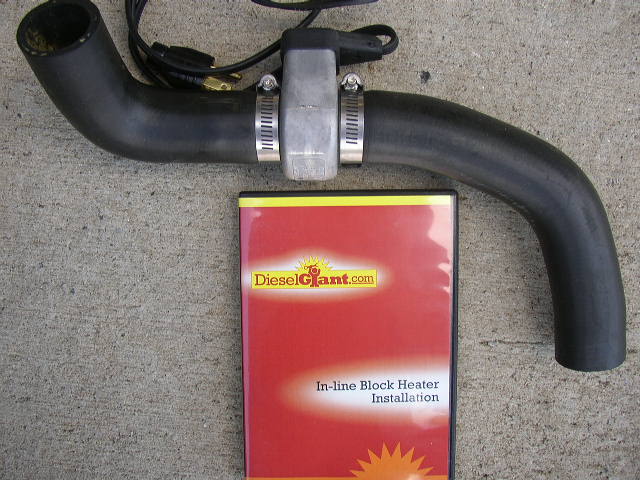I have a ton of experience operating and maintaining fleets of cars, trucks and weird stuff like these marvelous gasoline and diesel Sno-Cats in arctic winter conditions for a state agency over a period of 11 years.

You guys who use synthetic oil with a cold engine and do short warm-ups are on the right track because synthetic oil will usually allow short duration, minimal load, out-of-correct-geometry piston wall clearance operation* without noticable wear (unless you're getting oil dullition from a drastically over-rich condition resulting in cylinder wall gasoline flood - can you tell?), but for Ecomodders that's not sufficient for good mileage. Your computer will force a rich fuel mixture until the water temperature and/or the air feed** into your air cleaner reaches 150-160 f or so, maybe higher. For the best mileage to your short or long destinations, you have to use an electric water heater to attain operating temperature or close to operating temp before engine start.
*All pistons, forged or cast, are elliptical when cold. When cold, the piston pin axis is shorter than its perpendicular component. This is due to the fact that the casting around the pin expands farther with heat than the does the skirt. Therefore a cold piston, which is elliptical and resting inside a perfectly circular bore, presents a greater exposure of oil and compression ring area along the piston pin than the perpendicular axis until the engine warms up. Therefore, in theory, it is not a good idea to place a load upon a cold engine because of this assymetry (due to unequal loading of the piston rings), which also could result in ring groove deformation or ring shear.
**If your air-feed tubing from the exhaust manifold air heater to the cold air cleaner intake port isn't hooked up or your air cleaner thermostat butterfly isn't working properly, you risk running rich ALL THE TIME! I have seen a lot of guys disconnect this stuff for performance, thinking it will enhance airflow. This is dumb. If what you want is max airflow, just put on a taller air cleaner and raise the lid off its seat. Air will come in from all around which is great for full throttle applications -- if the computer air flow temp has been bypassed. But for mpg applications, keep the air cleaner circuit stock. This circuit is vital for telling the computer to change the mixture from cold rich to warm lean. You don't want to mess this up. There is another thread on Ecomodder where I responded to a guy who had a car where this was totally screwed up. He was getting 12 mpg from a 4-cyl Toyota!
There are two types. The one I do not recommend inserts into a block plug and is the cheapest.

These often do not warm up the entire cooling system because they only work by convection.

The one I would choose is the lower radiator hose pump heater. They really do the job! These come in several wattage versions, and depending on where you are and how cold it gets, you should choose one that warms your water to 120-degrees f or higher in the two hours of early morning before you go to work. If you don't know which one to get, choose the big one and run it for a shorter period.
Now, this is the trick. Get a timer that is designed to handle the load plus the line resistance of your extension cord (for a 100-foot cord, double the rating VxA=W). Set the timer to come on two hours before you start the car in the morning. Pop the hood and feel the upper radiator hose. It should be toasty. Now feel the top of the radiator, if it is still cold, this indicates that the water is not warm enough to pop the thermostat open and flow warm water through the radiator and back down into the engine, so set the timer for 2 and a half hours and try it the next day. Keep bumping up the duration until it works. This method will save you the most money in electricity, and the savings of gasoline by not running rich will apply against the electrical expense.
In the lower 48, there is usually a gain to be had in cost if you do this right. In the Arctic, you often have to do this for your vehicle to even start at all so it doesn't matter.
There are two additional benefits, beyond dramatically increased mpg. Your heater and defroster wll work instantly at full heat and your engine will last longer. DO NOT RUN YOUR DEFROSTER ON HIGH IF YOU DO THIS. You can crack your windshield from the sudden thermal expansion. I know. I have done this!
Something else I have done is to add one of those ceramic disc heaters to the engine heat system. The metal cases are best. Just mount it sideways to your firewall in the cabin on the passenger side with the switch on and wire it into the engine heat circuit. You'll come out to your vehicle in the morning with all the windows clear and warm and toasty inside.
If you take a climate like Chicago, for example, where electricity is .11 per kwh, then 2 hours at 3600 watts costs 2 x 3.6 x 11 = 79.2 cents. If your vehicle gets 20 miles to the gallon when warm, and 8 mpg when cold, an 8 mile trip to work can use, say, a quarter of a gallon for the first 2 miles and a third of a gallon for the next 6 miles. If gasoline is $2.60 per gallon:
(.25 x $2.60) + (.33 x $2.60) = $1.51 without the water heater.
With the water heater, you get
(8/20) x $2.60 = $1.04
The difference is $1.51 - $1.04 = $0.47 for one way.
So you have spent $0.792 to heat your engine and warm up your car, and you have saved $0.47 in fuel. This means it costs you
$0.47 - $0.792 = -$0.32 or $1.60 per week to have a toasty warm car with clear windshields every morning. But I think this is for like 10 or 15 degrees f, so it looks a lot better when it is a little warmer. One thing you can do is mark the temps on the timer dial, once you get this figured out for your vehicle. I think you'll come out ahead over the season.
All my water heaters have paid for themselves not particularly in gas savings, but in labor savings. Block heaters prevent expensive service calls to start a cold vehicle or worse, a rescue from a remote layover.
Is it worth it for you? How would I know? I live in southern California now. There is a reason! It's no longer an issue.
